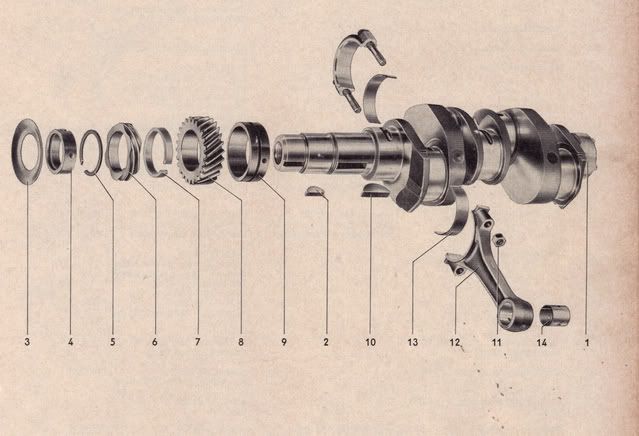What is it?
I don't recognize it...No reference to an Oil Slinger in either Muir or Bentley
What is it?
I don't recognize it...No reference to an Oil Slinger in either Muir or Bentley
Replies sorted oldest to newest
In a lawn mower engine it is a paddle like prong added to the bottom of a connecting rod to help lubricate a engine In aT model ford it was a worm cut in the end of a crankshaft that slings the oil back into the engine working like a seal at the ends What ya got what ya workin on???
Scroll down to 7th row of pictures, left picture.
The Bentley manual calls it an "Oil Deflector Plate", which is German for 'Oil Slinger'.
Section 17.3 Disassembling and assembling Crankshaft, left-most item in the pictorial (item 1)
There is no rear (pulley end) main seal on a VW crankshaft unless someone has installed a so-called "sand seal". Instead, just inside of the case there is a circular void in which rides that Oil slinger which spins the oil off of the crankshaft from centrifugal force and it runs back into the sump.
THAT is why some engines get a bit of oil out behind the fan belt pulley at the crank. The internal case pressure can blow some oil out beyond the slinger and it drips onto the floor. That's also why there's a hole in the engine tin-work just below the crank pulley.
gn
Carl, here is a direct link: http://www.ebay.com/itm/Oil-Sl...n-Ghia-/310369814889
Basically, a big curved washer to sling any oil back into the crankcase rather than letting it seep out the front pulley. There is no front seal unless you have a sand seal pulley, most of us don't I am guessing. Also, there is a groove machined into the crank pulley designed to push any oil back into the crankcase, or does it just push air back, I don't know. Here: https://www.mofoco.com/item_im...ankshaft_pulley.jpeg
'What I've got', oldyeler, is a book of knowledge with a whole lot of blank pages!!...
Thank you guys. You're filling those blank pages for me. Like Jim Ignacio said, I also learn something new everytime I open this forum.
Call-out number 3 is "oil deflection plate" or "slinger"

Carl,
I also found the the old German crank pulleys may not look as cool as a nice aluminum after market pulley but if you have a oil leak in this area and you are venting the engine correctly the original part will usually resolve the leak - ask me how I know. The machining on the German pulley is almost always better then the Chinese repro.
I thought Model T's had a rope mainseal? I know they had the shallow worm groove machined into the crankshaft, but thought there was a rope-like seal either in the end bearing cap or a separate, bolt-on seal cap in the block. Maybe I'm cornfusing it with the later 59A/B block (which I'm more familiar with) but I still have the tiny corkscrew tool used to thread into the end of the rope to pull it out and pull the new one in when it wears out and leaks. Amazingly primitive, but the darned thing worked!
Oh that thing I'd call it a deflector . I like how sand rail Dune buggy's use a sand seal kit for even more protection as well as that. It can help..
Access to this requires a premium membership.
Supporting members have donated about $4.00 a month ($49.00 US per year) paid annually.
AUTO RENEW: You membership will auto-renew after 12 months. If you prefer not to auto-renew, you can cancel your premium membership at any time and it will remain in effect until the end of the 12 months. To cancel, sign in at SpeedsterOwners.com and navigate to: (Your User Name) > Premium Membership.
PLEASE NOTE: Your credit card will receive a charge from CROWDSTACK PAY, the payment processor, not SpeedsterOwners.com.